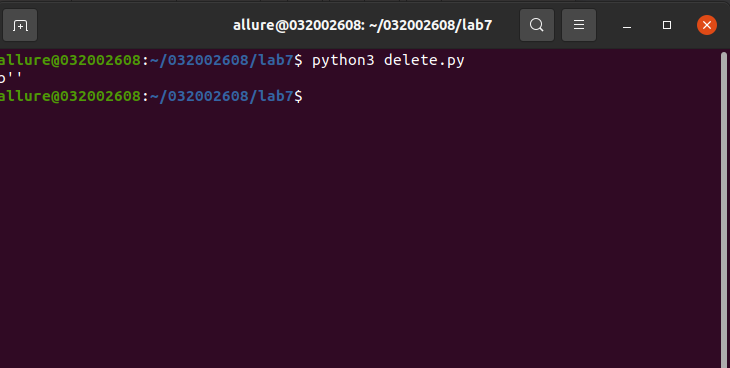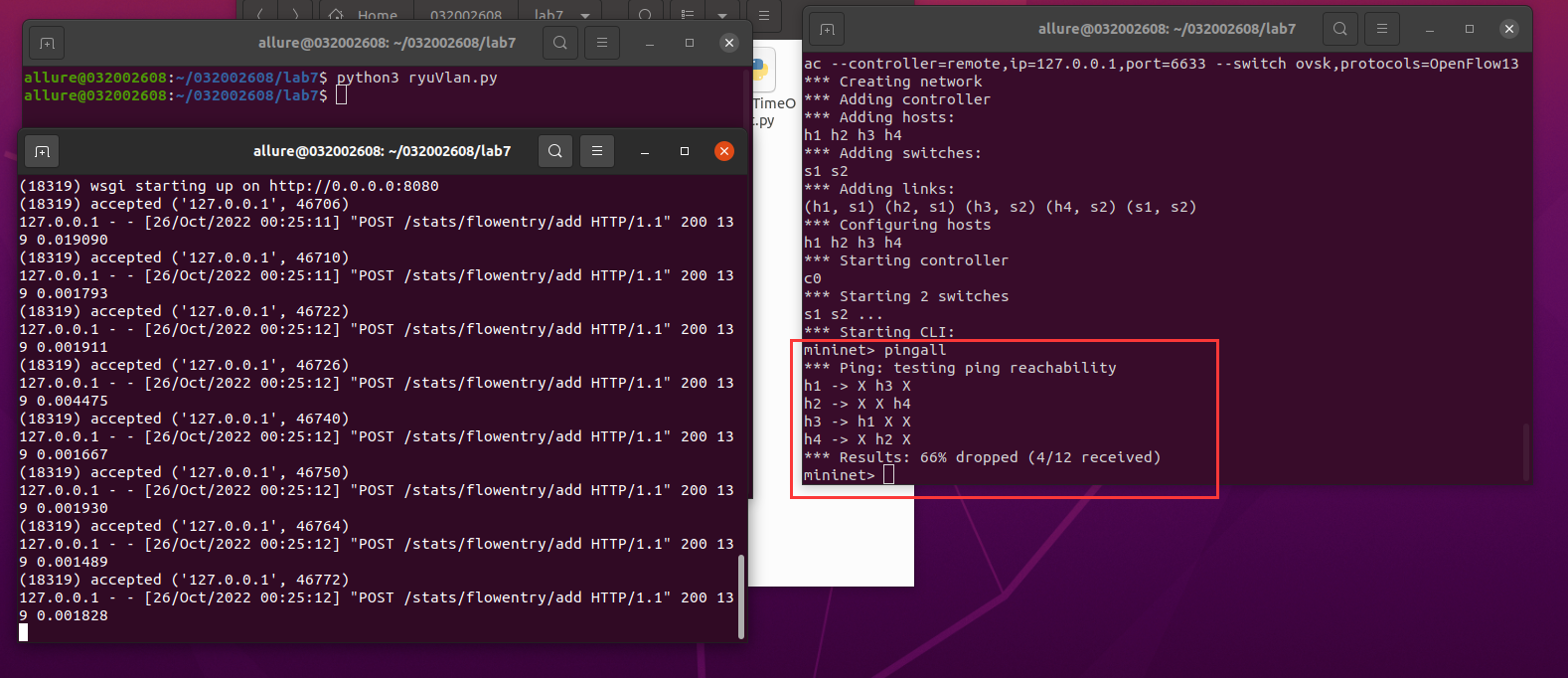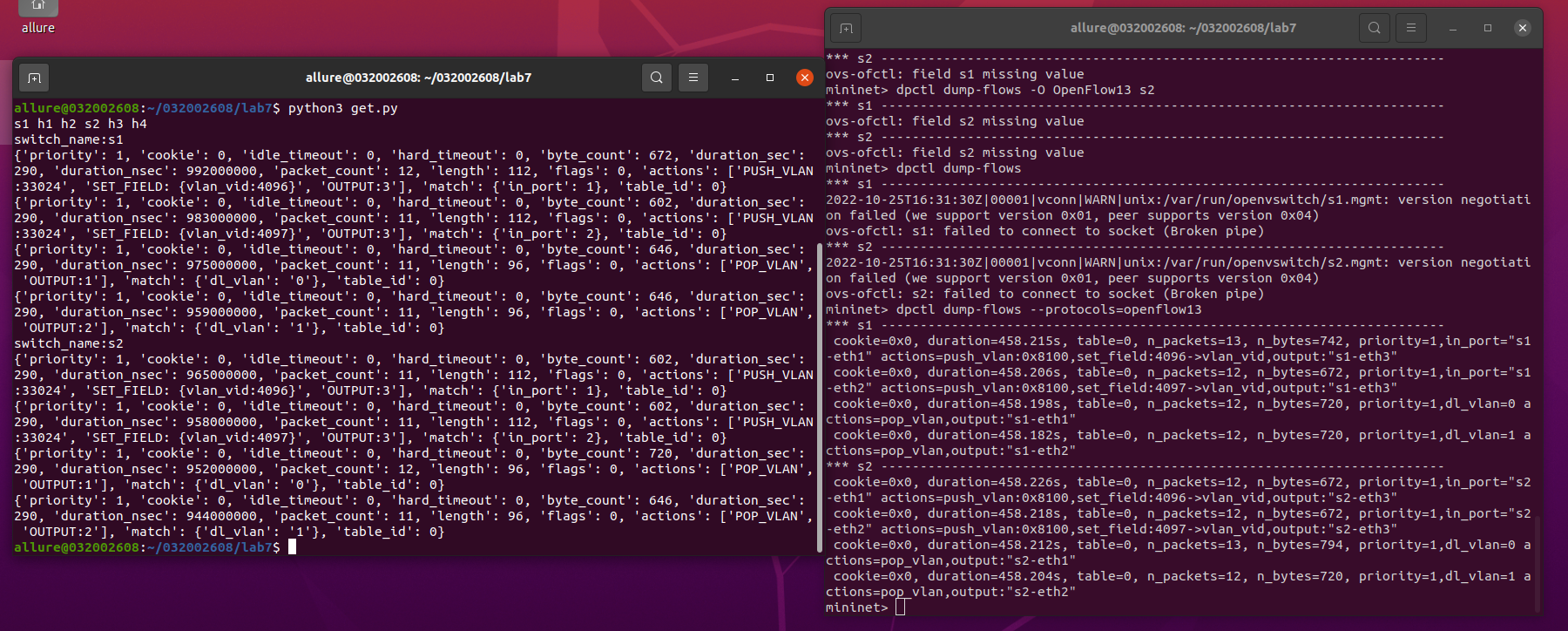实验7:基于REST API的SDN北向应用实践
一、实验目的
- 能够编写程序调用OpenDaylight REST API实现特定网络功能;
- 能够编写程序调用Ryu REST API实现特定网络功能。
二、实验环境
- 下载虚拟机软件Oracle VisualBox或VMware;
- 在虚拟机中安装Ubuntu 20.04 Desktop amd64,并完整安装Mininet、OpenDaylight(Carbon版本)、Postman和Ryu;
三、实验要求
(一)基本要求
- 编写Python程序,调用OpenDaylight的北向接口实现以下功能
(1) 利用Mininet平台搭建下图所示网络拓扑,并连接OpenDaylight;
(2) 下发指令删除s1上的流表数据。
(3) 下发硬超时流表,实现拓扑内主机h1和h3网络中断20s。
(4) 获取s1上活动的流表数。
(1)利用Mininet平台搭建下图所示网络拓扑,并连接OpenDaylight

(2) 下发指令删除s1上的流表数据
import requests
from requests.auth import HTTPBasicAuth
if __name__ == '__main__':
url = 'http://127.0.0.1:8181/restconf/operational/opendaylight-inventory:nodes/node/openflow:1/'
headers = {'Content-Type': 'application/json'}
resp = requests.delete(url=url, headers=headers, auth=HTTPBasicAuth('admin', 'admin'))
print(resp.content)

(3) 下发硬超时流表,实现拓扑内主机h1和h3网络中断20s
HardTimeOut.py
import requests as rq
from requests.auth import HTTPBasicAuth
def http_put(url,jstr):
url= url
headers = {'Content-Type':'application/json'}
resp = rq.put(url,jstr,headers=headers,auth=HTTPBasicAuth('admin', 'admin'))
return resp
if __name__ == "__main__":
url='http://127.0.0.1:8181/restconf/config/opendaylight-inventory:nodes/node/openflow:1/flow-node-inventory:table/0/flow/1'
with open('./HardTimeOut.json') as f:
jstr = f.read()
resp = http_put(url,jstr)
print (resp.content)
HardTimeOut.json
{
"flow": [
{
"id": "1",
"match": {
"in-port": "1",
"ethernet-match": {
"ethernet-type": {
"type": "0x0800"
}
},
"ipv4-destination": "10.0.0.3/32"
},
"instructions": {
"instruction": [
{
"order": "0",
"apply-actions": {
"action": [
{
"order": "0",
"drop-action": {}
}
]
}
}
]
},
"flow-name": "flow1",
"priority": "65535",
"hard-timeout": "20",
"cookie": "2",
"table_id": "0"
}
]
}

(4) 获取s1上活动的流表数
import requests as rq
from requests.auth import HTTPBasicAuth
def http_get(url):
url= url
headers = {'Content-Type':'application/json'}
resp = rq.get(url,headers=headers,auth=HTTPBasicAuth('admin','admin'))
return resp
if __name__ == "__main__":
url='http://127.0.0.1:8181/restconf/operational/opendaylight-inventory:nodes/node/openflow:1/flow-node-inventory:table/0/opendaylight-flow-table-statistics:flow-table-statistics'
resp = http_get(url)
print(resp.content)

- 编写Python程序,调用Ryu的北向接口实现以下功能
(1) 实现上述OpenDaylight实验拓扑上相同的硬超时流表下发。
(2) 参考Ryu REST API的文档,基于VLAN实验的网络拓扑,编程实现相同的VLAN配置。
提示:拓扑生成后需连接Ryu,且Ryu应能够提供REST API服务
(1) 实现上述OpenDaylight实验拓扑上相同的硬超时流表下发
Timeout.py
import requests
from requests.auth import HTTPBasicAuth
if __name__ == "__main__":
url = 'http://127.0.0.1:8080/stats/flowentry/add'
with open("./Timeout.json") as f:
jstr = f.read()
headers = {'Content-Type': 'application/json'}
res = requests.post(url, jstr, headers=headers)
print (res.content)
Timeout.json
{
"dpid": 1,
"cookie": 1,
"cookie_mask": 1,
"table_id": 0,
"hard_timeout": 20,
"priority": 65535,
"flags": 1,
"match":{
"in_port":1
},
"actions":[
]
}

(2) 参考Ryu REST API的文档,基于VLAN实验的网络拓扑,编程实现相同的VLAN配置
ryuTopo.py
from mininet.topo import Topo
class MyTopo( Topo ):
def __init__( self ):
Topo.__init__(self)
# Add hosts and switches
host1 = self.addHost('h1')
host2 = self.addHost('h2')
host3 = self.addHost('h3')
host4 = self.addHost('h4')
switch1 = self.addSwitch('s1')
switch2 = self.addSwitch('s2')
# Add links
self.addLink(host1,switch1,1,1)
self.addLink(host2,switch1,1,2)
self.addLink(host3,switch2,1,1)
self.addLink(host4,switch2,1,2)
self.addLink(switch1,switch2,3,3)
topos = { 'mytopo': ( lambda: MyTopo() ) }
ryuVlan.py
import requests
import json
if __name__ == "__main__":
url = 'http://127.0.0.1:8080/stats/flowentry/add'
headers = {'Content-Type': 'application/json'}
flow1 = {
"dpid": 1,
"priority": 1,
"match":{
"in_port": 1
},
"actions":[
{
"type": "PUSH_VLAN",
"ethertype": 33024
},
{
"type": "SET_FIELD",
"field": "vlan_vid",
"value": 4096
},
{
"type": "OUTPUT",
"port": 3
}
]
}
flow2 = {
"dpid": 1,
"priority": 1,
"match":{
"in_port": 2
},
"actions":[
{
"type": "PUSH_VLAN",
"ethertype": 33024
},
{
"type": "SET_FIELD",
"field": "vlan_vid",
"value": 4097
},
{
"type": "OUTPUT",
"port": 3
}
]
}
flow3 = {
"dpid": 1,
"priority": 1,
"match":{
"vlan_vid": 0
},
"actions":[
{
"type": "POP_VLAN",
"ethertype": 33024
},
{
"type": "OUTPUT",
"port": 1
}
]
}
flow4 = {
"dpid": 1,
"priority": 1,
"match": {
"vlan_vid": 1
},
"actions": [
{
"type": "POP_VLAN",
"ethertype": 33024
},
{
"type": "OUTPUT",
"port": 2
}
]
}
flow5 = {
"dpid": 2,
"priority": 1,
"match": {
"in_port": 1
},
"actions": [
{
"type": "PUSH_VLAN",
"ethertype": 33024
},
{
"type": "SET_FIELD",
"field": "vlan_vid",
"value": 4096
},
{
"type": "OUTPUT",
"port": 3
}
]
}
flow6 = {
"dpid": 2,
"priority": 1,
"match": {
"in_port": 2
},
"actions": [
{
"type": "PUSH_VLAN",
"ethertype": 33024
},
{
"type": "SET_FIELD",
"field": "vlan_vid",
"value": 4097
},
{
"type": "OUTPUT",
"port": 3
}
]
}
flow7 = {
"dpid": 2,
"priority": 1,
"match": {
"vlan_vid": 0
},
"actions": [
{
"type": "POP_VLAN",
"ethertype": 33024
},
{
"type": "OUTPUT",
"port": 1
}
]
}
flow8 = {
"dpid": 2,
"priority": 1,
"match": {
"vlan_vid": 1
},
"actions": [
{
"type": "POP_VLAN",
"ethertype": 33024
},
{
"type": "OUTPUT",
"port": 2
}
]
}
res1 = requests.post(url, json.dumps(flow1), headers=headers)
res2 = requests.post(url, json.dumps(flow2), headers=headers)
res3 = requests.post(url, json.dumps(flow3), headers=headers)
res4 = requests.post(url, json.dumps(flow4), headers=headers)
res5 = requests.post(url, json.dumps(flow5), headers=headers)
res6 = requests.post(url, json.dumps(flow6), headers=headers)
res7 = requests.post(url, json.dumps(flow7), headers=headers)
res8 = requests.post(url, json.dumps(flow8), headers=headers)

(二)进阶要求
OpenDaylight或Ryu任选其一,编程实现查看前序VLAN实验拓扑中所有节点(含交换机、主机)的名称,以及显示每台交换机的所有流表项。
import requests
import time
import re
class GetNodes:
def __init__(self, ip):
self.ip = ip
def get_switch_id(self):
url = 'http://' + self.ip + '/stats/switches'
re_switch_id = requests.get(url=url).json()
switch_id_hex = []
for i in re_switch_id:
switch_id_hex.append(hex(i))
return switch_id_hex
def getflow(self):
url = 'http://' + self.ip + '/stats/flow/%d'
switch_list = self.get_switch_id()
ret_flow = []
for switch in switch_list:
new_url = format(url % int(switch, 16))
re_switch_flow = requests.get(url=new_url).json()
ret_flow.append(re_switch_flow)
return ret_flow
def show(self):
flow_list = self.getflow()
for flow in flow_list:
for dpid in flow.keys():
dp_id = dpid
switchnum= '{1}'.format(hex(int(dp_id)), int(dp_id))
print('s'+switchnum,end = " ")
switchnum = int(switchnum)
for list_table in flow.values():
for table in list_table:
string1 = str(table)
if re.search("'dl_vlan': '(.*?)'", string1) is not None:
num = re.search("'dl_vlan': '(.*?)'", string1).group(1);
if num == '0' and switchnum == 1:
print('h1',end = " ")
if num == '1' and switchnum == 1:
print('h2',end = " ")
if num == '0' and switchnum == 2:
print('h3',end = " ")
if num == '1' and switchnum == 2:
print('h4',end = " ")
print("")
flow_list = self.getflow()
for flow in flow_list:
for dpid in flow.keys():
dp_id = dpid
print('switch_name:s{1}'.format(hex(int(dp_id)), int(dp_id)))
for list_table in flow.values():
for table in list_table:
print(table)
s1 = GetNodes("127.0.0.1:8080")
s1.show()

四、个人总结
在实验过程中发现,使用代码sudo ovs-ofctl dump-flows s1无法查看交换机上的流表

询问同学后得知,是因为版本不匹配,需要使用sudo ovs-ofctl dump-flows --protocols=Openflow13查看流表
在实验过程中需要使用sudo mn -c清楚拓扑,否则实验结果会出现错误
本次实验难度较大,是之前实验的综合,同时代码量也非常大,其中部分功能同之前一样需要查看英文文档,可惜之前未记录相关知识,导致此次实验还需再次查阅文档。通过本次实验,我也学会了编写程序调用OpenDaylight REST API和Ryu REST API实现特定网络功能,也复习了之前所学的知识,如VLAN的设置、硬超时的设置等,以及更深理解相关操作,像查看流表需要随版本而变。除此之外,还进一步学习了python的request库。这次实验让我将所学知识综合运用了起来,对于SDN的整体架构有了进一步的了解,希望将来有机会可以继续学习。


